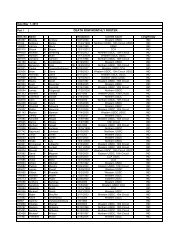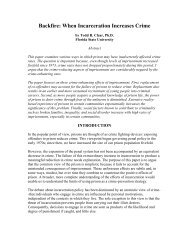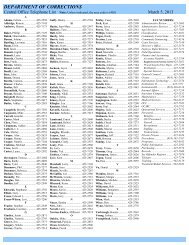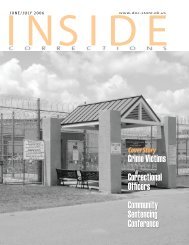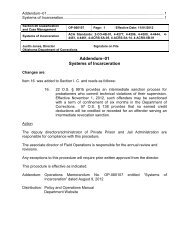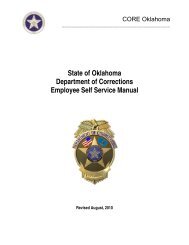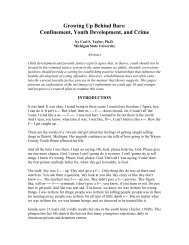Programs, Mental Health, Medical & Education - Oklahoma ...
Programs, Mental Health, Medical & Education - Oklahoma ...
Programs, Mental Health, Medical & Education - Oklahoma ...
Create successful ePaper yourself
Turn your PDF publications into a flip-book with our unique Google optimized e-Paper software.
Treatment and Rehabilitative Services - <strong>Mental</strong> <strong>Health</strong> Services<br />
(<strong>Mental</strong> <strong>Health</strong> Services, cont. from page 17)<br />
is often most complex when they are seeking justification for<br />
single cell placement. <strong>Mental</strong> <strong>Health</strong> becomes involved because<br />
the alternative method for being single celled is contraindicated<br />
for their ultimate goal of clemency. For a security based single<br />
cell, the offender must have a pattern of repeated assaults or<br />
be repeatedly assaulted with a documented injury. Fighting<br />
ruins the case for being reformed. Consequently, the offender<br />
has to prove that double celling causes extreme distress and<br />
relies on mental health staff to make the<br />
determination.<br />
Another Death Row focus is “closure.”<br />
Many offenders are making peace with their<br />
pending death and strangely find that life<br />
with a foreseeable end has meaning. Many<br />
offenders do reminiscence work; discuss<br />
finding the right way to explain the process<br />
to their families. Others struggle with their<br />
legacy - whether it is pain for the victim’s<br />
family or shame for their own family or even<br />
pride for doing something they ultimately<br />
believe was altruistic. Despite what one<br />
might imagine, it is not morbid, there is<br />
no anger, fear or angst. There is usually a<br />
surprising calm. Death Row is a world onto<br />
itself but ultimately similar to practice in<br />
the community, where clients choose to seek<br />
services.<br />
Offenders on the Disciplinary unit are<br />
those on lock up for various violations of<br />
the facility rules. These offenders are placed<br />
in cells with other offenders they may not<br />
know, whom they may fear, or hate. D/U<br />
is terrifying for many because of the unknowns. Offenders<br />
are often angry at placement on D/U and may destroy the<br />
cells, damaging light fixtures, flooding, breaking the toilet.<br />
The offenders who follow the destruction are at times forced<br />
to live in squalor. Consequently, D/U offenders have many<br />
demands and many crises. Because they can be reminded that<br />
18 JULY/AUGUST 2011<br />
They also avoid<br />
treatment<br />
because having<br />
insight into<br />
their behavior<br />
creates the<br />
need for<br />
change and<br />
accountability<br />
which goes<br />
against the<br />
ultimate goal<br />
of remaining<br />
on H-Unit.<br />
the situation is temporary, they are generally easily calmed and<br />
barring any assault by cell mates or staff, adjust quickly and<br />
return to general population from whence they came.<br />
The most complex group by far is Administrative Segregation<br />
(AS). AS is housing for those who are considered<br />
unmanageable in the general population. Unfortunately, for<br />
some offenders, H-Unit on Administrative Segregation is the<br />
zenith of a criminal career. To have proven to be dangerous<br />
enough or bad enough to not only be in<br />
a maximum security prison, but to prove<br />
so unmanageable among other criminals<br />
that special housing and management are<br />
needed, is an accomplishment to be sure.<br />
These offenders bask in the glory that is<br />
H-Unit. They are like infants swaddled and<br />
secure. They have few needs or demands.<br />
They rarely engage actively in the madness<br />
and serve as consultants to underlings and<br />
at times the administration. For these<br />
offenders, providing a book to read to<br />
pass the time was plenty. It validated that<br />
someone remained aware of their existence<br />
and treatment for these individuals boiled<br />
down to staving off boredom and sensory<br />
deprivation.<br />
On the other extreme are those offenders<br />
who have engaged in so many annoying,<br />
inconvenient, and generally ridiculous<br />
behaviors that they are placed on H-Unit<br />
where their behavior does not adversely<br />
impact the successful operation of the<br />
facility. For these offenders, they are safe<br />
and in a single cell where no one can get to them. They are<br />
content and act out only enough to ensure that they remain<br />
disruptive enough that they will not be returned to general<br />
population. These offenders tend to be high maintenance not<br />
because they desire or engage in treatment but rather because<br />
of the constant need to document the latest shenanigans. They<br />
(continued on page 34)



